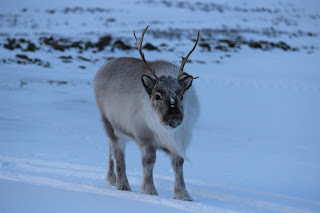The sun rose above the horizon for the first time on
February 15th. However, Longyearbyen is surrounded my mountains,
such that the sun will not shine on the town until 8th march. Despite
the sun not being directly in the sky, it seems we are now in a normal day and
night cycle, with daylight during the day, and darkness during the night. It is
nice to properly see our surroundings now we have come out of polar night. With
spring on its way, more wildlife is starting to make itself known, with
numerous birds, more visits from the reindeer, and a sneaky arctic fox. So I
have read, there are around 30 birds on Svalbard during the spring and summer,
most of which have migrated over from the mainland.
I had another walk to the beach, now, the sunlight baths the
tips of the mountains, and there is a beautiful pink glow. As you can see in
the picture below, there were multiple chunks of sea ice floating in the water,
one of those ‘I’m in the arctic’ feels that I get each time something is really
really different from back home, such as the snow storms and the deep snow we trek
through.
A group of us took a trip to the well known ice caves in
Larshbreen. We visited two of the caves, which, as the name says, are just full
of ice. The walls are ice, the ceiling is ice, and the floor is ice, so if you
ever want to visit, make sure you are wearing your spikes! Getting down into
the caves proved quite scary for myself. Initially a hole in the floor which
you climb through, leading to a steep, very small tunnel, which goes further
and further down until you reach the underground caves. The two caves, were
very different from each other. The one seemed to be mainly smooth ice, of
which you could see all the different layers beneath. The other had a lot of
crystal ice, and icicles, and seemed to be much more sparkly. Both different,
both beautiful.
Following our trip to the caves, a bonfire was made in the
evening to celebrate the last night of proper darkness, before the sun rises
higher and higher and eventually no longer set. The bonfire was warm in the
freezing cold air, and to our great luck, the aurora came out to dance above
us. Arctic + Bonfire + Snow + Mountains + Aurora = One magical feeling.
In the nights following, we were treated to more aurora, and
we certainly made the most of seeing it, as before long, the sunlight will make
it invisible to our naked eye. I can’t wait for the sun to be shining, but I
sure will miss the natural beauty that is the Aurora.
That is all for now.
Check out the video of the adventures linked below, and stay
tuned for the next installment!
Ser
deg seinare!

















































